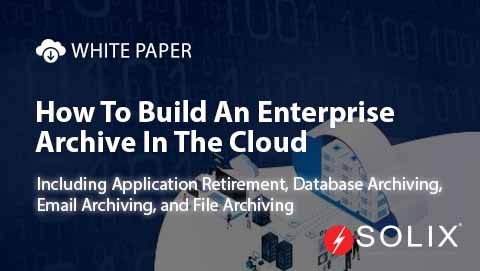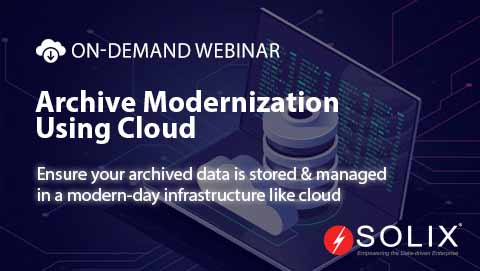Data Archiving Tools Architecture Everything You Need to Know
When diving into the world of data management, one question often looms larger than the rest how do I efficiently archive my data Thats where understanding data archiving tools architecture comes into play. It serves as the backbone for sustainable data retention and management strategies. In this blog post, well explore what data archiving tools architecture entails, why it matters, and how it connects to solutions offered by companies like Solix.
Imagine youre managing an organization with immense data volume. Every day, you generate gigabytes or even terabytes of informationcustomer records, transaction histories, compliance documentationas well as unstructured data from emails, social media, and more. With the growth of your information assets, maintaining efficiency and compliance becomes increasingly complex. This is where a solid data archiving tools architecture enters the picture, acting as a systematic approach to archiving, securing, and retrieving data efficiently.
What is Data Archiving Tools Architecture
Data archiving tools architecture refers to the structured framework and methodologies that organizations use to archive their data. This architecture involves employing various toolssoftware and servicesthat manage how data is stored, accessed, and protected over time. When designed correctly, it creates an efficient environment for preserving information while ensuring it remains accessible for analysis or compliance when necessary.
A good data archiving tools architecture isnt just about having a storage solution; it needs to encompass several key elements data classification, storage optimization, security protocols, and robust retrieval mechanisms. Each of these components plays a crucial role in ensuring that your organization can meet regulatory requirements while maximizing data utility.
The Importance of Data Archiving Tools Architecture
Investing in a solid data archiving tools architecture is paramount for several reasons. Firstly, it supports compliance with regulations, such as GDPR or HIPAA. Organizations that fail to properly archive their data may face significant fines and reputational damage. Secondly, a well-structured architecture eliminates redundant data and significantly reduces storage costs. Storing data efficiently means that businesses can allocate resources where they are needed most.
Moreover, an effective data archiving tools architecture promotes enhanced data retrieval capabilities. Its not just about storing informationits about retrieving it quickly when needed. Poorly designed architectures can lead to data bottlenecks, hindering business operations. Companies must be able to access archived data when required, whether for legal reviews, auditing, or simply making data-driven business decisions.
Components of a Robust Data Archiving Tools Architecture
Now that weve established the importance of data archiving tools architecture, lets break down its key components
- Data Classification This is the process of categorizing data based on its importance and compliance requirements. By understanding the criticality of different data types, organizations can create strategies for archiving them effectively.
- Storage Optimization This involves selecting the right storage mediums, whether on-premises, cloud-based, or hybrid solutions. Optimization ensures that the archiving strategy remains cost-effective and scalable.
- Security Measures Data must be safeguarded against unauthorized access and breaches. Therefore, implementing strong encryption, access controls, and continuous monitoring is essential.
- Retrieval Mechanisms Efficient retrieval systems must be in place to ensure timely access to archived data. Consider how youll query, search, and process archived information based on user needs.
Lessons Learned My Personal Experience
Let me share a quick story that emphasizes the significance of effective data archiving tools architecture. A few years back, I worked with a mid-sized company that was expanding rapidly. Despite growing data demands, they didnt prioritize their data archiving. Major issues arose when they suddenly needed to audit several years worth of transaction data for compliance purposes. The chaotic data retrieval process took weeks and led to frustration among employees and even risked an audit failure.
This experience drove home a critical lesson for me having a robust data archiving architecture is not optional; its essential. After this incident, the company decided to overhaul its data management strategy with a focus on implementing a well-structured solution. They engaged passionate professionals to simplify the process, streamline access, and ensure compliance from that point forward. The results were transformative, leading to optimized operations and greater peace of mind.
How Solix Can Help
When considering the implementation of a data archiving tools architecture, partnering with a trusted provider can make all the difference. Thats where Solix comes in. With their expertise in data management solutions, Solix offers a range of services tailored to meet your organizations data archiving needs. For example, their Solix Enterprise Data Archiving solution is designed to simplify data classification, ensure data integrity, and secure your information against unauthorized access.
This tailored solution helps organizations not only improve compliance but also reduce costs associated with data storage. By leveraging Solix architecture and expertise, businesses can enjoy peace of mind knowing that their valuable information is structured, accessible, and secure.
Get in Touch for More Information
If youre considering or currently struggling with your data archiving tools architecture, its essential to consult with experts who understand the landscape. I wholeheartedly recommend reaching out to Solix to explore how their solutions can simplify your data challenges. You can call them at 1.888.GO.SOLIX (1-888-467-6549) or contact them through their website for more personalized assistance. Their team is keen to help refine your data strategies and adapt to your organizational needs.
Wrap-Up The Path to Structured Data Management
Data archiving tools architecture is a cornerstone of effective data management. Understanding its components can empower organizations to develop strategies that are not only compliant but also resource-efficient. From my own experiences and lessons learned, I can assure you that investing in a structured approach makes a significant difference in managing your data landscape.
As you navigate the complex world of data archiving, remember to leverage the right tools and partners, like Solix, to guarantee your organizations success. Together, you can build an architecture that supports both todays requirements and future growth.
About the Author
Jamie is an advocate for effective data management, specializing in data archiving tools architecture. With a passion for helping organizations streamline their data processes, Jamie has spent years advising businesses on best practices for efficient data usage and compliance.
Please note that the views expressed in this blog are solely those of the author and do not necessarily reflect the official position of Solix.
Sign up now on the right for a chance to WIN $100 today! Our giveaway ends soon‚ dont miss out! Limited time offer! Enter on right to claim your $100 reward before its too late!




